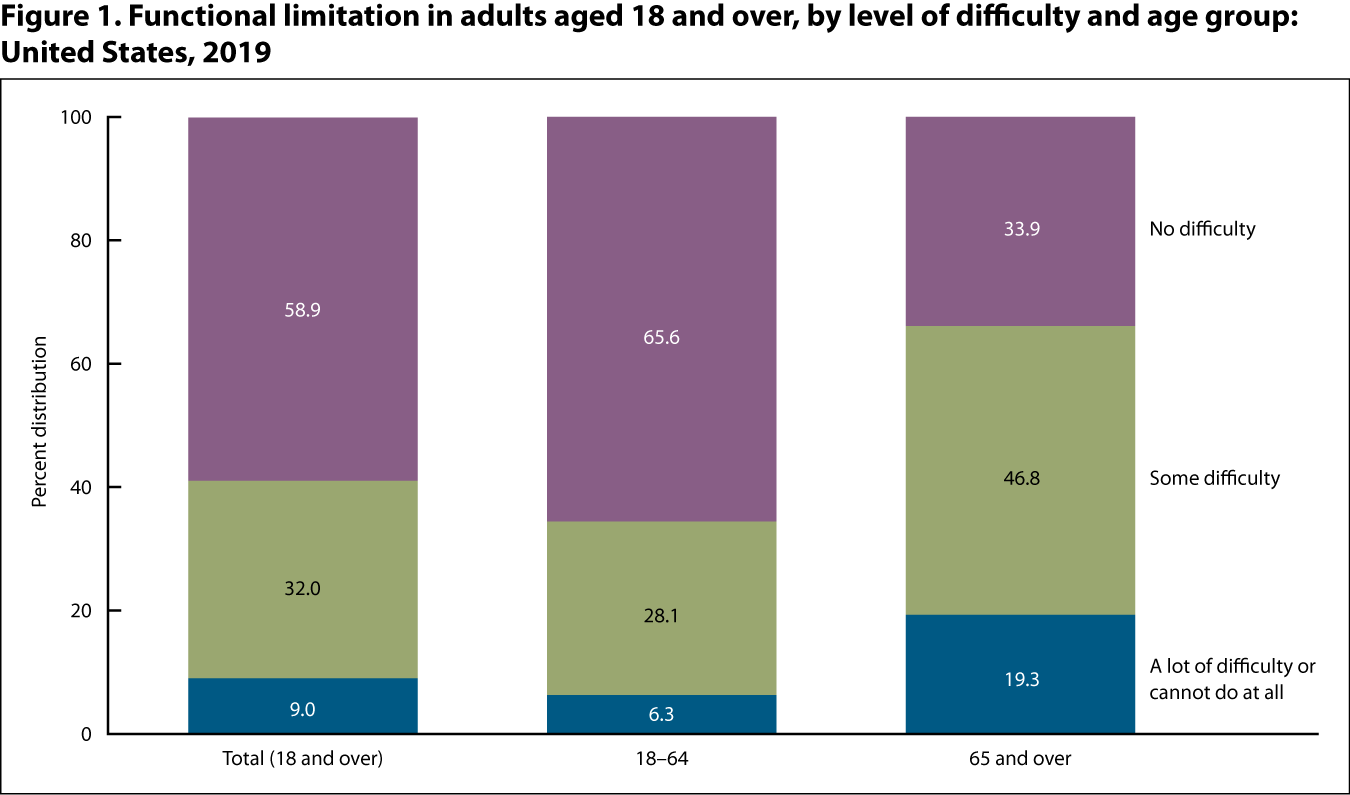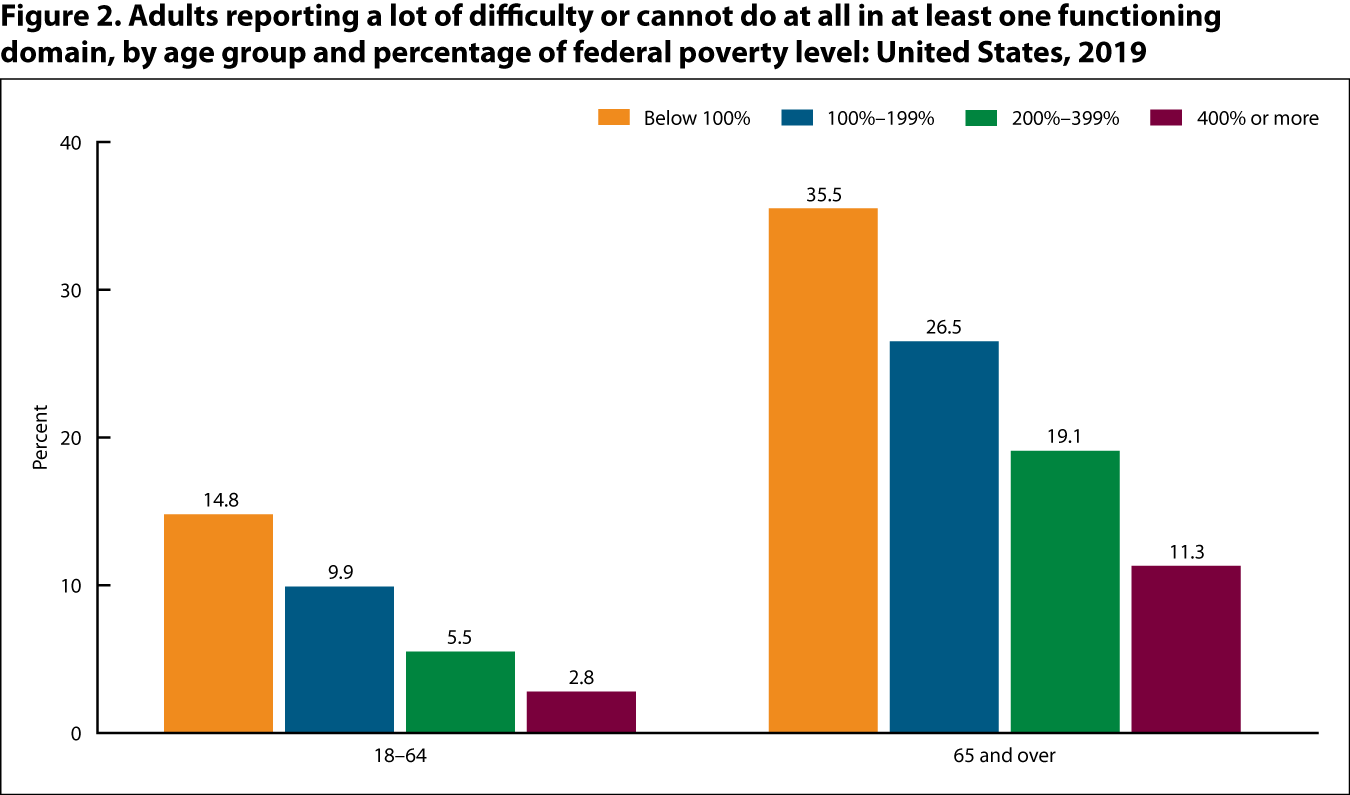Functional Limitation
The content on this page was last updated in June 2023. More recent estimates and visualizations may be available from the NCHS Data Query System.
Limitations in functioning may be a result of physical or mental impairments and can result in lower levels of educational attainment, employment, and participation in other daily activities (1–3). Functional limitation is defined by the reported level of difficulty (no difficulty, some difficulty, a lot of difficulty, or cannot do at all/unable to do) in six core functioning domains: seeing, hearing, mobility, communication, cognition, and self-care. Adults reporting “a lot of difficulty” or “cannot do at all” to at least one domain of functioning are considered to have disability.
Key Findings
A lot of difficulty or cannot do at all

The age-adjusted percentage of adults aged 18 and over who reported “a lot of difficulty or cannot do at all” in at least one of the six functioning domains did not change significantly from 2010 to 2018 (9.5% in 2018). In 2019, 8.2% of adults reported “a lot of difficulty or cannot do at all” in at least one functioning domain. See Featured Charts for additional analysis and Notes for more information about analyzing trends using NHIS data.
SOURCE: National Center for Health Statistics, National Health Interview Survey. See Sources and Definitions, National Health Interview Survey (NHIS) and Health, United States, 2020–2021 Table FxLimit [PDF – 361 KB].
Some difficulty

The age-adjusted percentage of adults aged 18 and over who reported “some difficulty” in at least one of the six functioning domains increased from 28.8% in 2010 to 32.2% in 2018. In 2019, 30.6% of adults reported “some difficulty” in at least one functioning domain. See Featured Charts for additional analysis and Notes for more information about analyzing trends using NHIS data.
SOURCE: National Center for Health Statistics, National Health Interview Survey. See Sources and Definitions, National Health Interview Survey (NHIS) and Health, United States, 2020–2021 Table FxLimit.
No difficulty

The age-adjusted percentage of adults aged 18 and over who reported “no difficulty” in all six functioning domains decreased from 62.6% in 2010 to 58.3% in 2018. In 2019, 61.2% of adults reported “no difficulty” in all functioning domains. See Featured Charts for additional analysis and Notes for more information about analyzing trends using NHIS data.
SOURCE: National Center for Health Statistics, National Health Interview Survey. See Sources and Definitions, National Health Interview Survey (NHIS) and Health, United States, 2020–2021 Table FxLimit.
In 2019, adults aged 65 and over were more likely to have functional limitation than adults aged 18–64.

SOURCE: National Center for Health Statistics, National Health Interview Survey. See Sources and Definitions, National Health Interview Survey (NHIS) and Health, United States, 2020–2021 Table FxLimit.
- In 2019, 9.0% of adults aged 18 and over reported “a lot of difficulty or cannot do at all” in at least one of the six functioning domains, while 32.0% reported “some difficulty” in at least one functioning domain.
- Adults aged 65 and over were more likely to experience functional limitation in at least one functioning domain (19.3% reported “a lot of difficulty or cannot do at all” and 46.8% reported “some difficulty”) than adults aged 18–64 (6.3% reported “a lot of difficulty or cannot do at all” and 28.1% reported “some difficulty”).
- Adults aged 18–64 were more likely to report “no difficulty” in any domain (65.6%) compared with adults aged 65 and over (33.9%).
Adults living below 100% of the federal poverty level (FPL) were more likely to report having “a lot of difficulty or cannot do at all” in at least one functioning domain compared with adults living at higher income levels in 2019.

SOURCE: National Center for Health Statistics, National Health Interview Survey. See Sources and Definitions, National Health Interview Survey (NHIS) and Health, United States, 2020–2021 Table FxLimit.
- In 2019, the percentage of adults reporting “a lot of difficulty or cannot do at all” in at least one functioning domain increased with decreasing FPL for adults aged 18–64 and 65 and over.
- Among adults aged 18–64 in 2019, the percentage reporting “a lot of difficulty or cannot do at all” in at least one of the six functioning domains was highest for those living below 100% of FPL (14.8%), followed by those living at 100%–199% (9.9%), 200%–399% (5.5%), and 400% or more of FPL (2.8%).
- Among adults aged 65 and over in 2019, the percentage reporting “a lot of difficulty or cannot do at all” in at least one functioning domain was highest for those living below 100% of FPL (35.5%), followed by those living at 100%–199% (26.5%), 200%–399% (19.1%), and 400% or more of FPL (11.3%).
- Functional limitation: Reported level of difficulty in six domains of functioning: seeing (even if wearing glasses), hearing (even if wearing hearing aids), mobility (walking or climbing stairs), communication (understanding or being understood by others), cognition (remembering or concentrating), and self-care (such as washing all over or dressing). See Sources and Definitions, Functional limitation.
- Poverty level: Based on family income, size, and composition using U.S. Census Bureau poverty thresholds. Missing family income data are imputed. See Sources and Definitions, Family income; Poverty.
- World Health Organization. International classification of functioning, disability, and health (ICF) 2001. Available from: https://www.who.int/classifications/icf/en/.
- Washington Group on Disability Statistics. WG Short Set on Functioning (WG-SS). Available from: https://www.washingtongroup-disability.com/fileadmin/uploads/wg/Documents/Rationale_WG_Short-1.pdf.
- Weeks JD, Dahlhamer JM, Madans JH, Maitland A. Measuring disability: An examination of differences between the Washington Group Short Set on Functioning and the American Community Survey disability questions. National Health Statistics Reports; no 161. Hyattsville, MD: National Center for Health Statistics. 2021.
